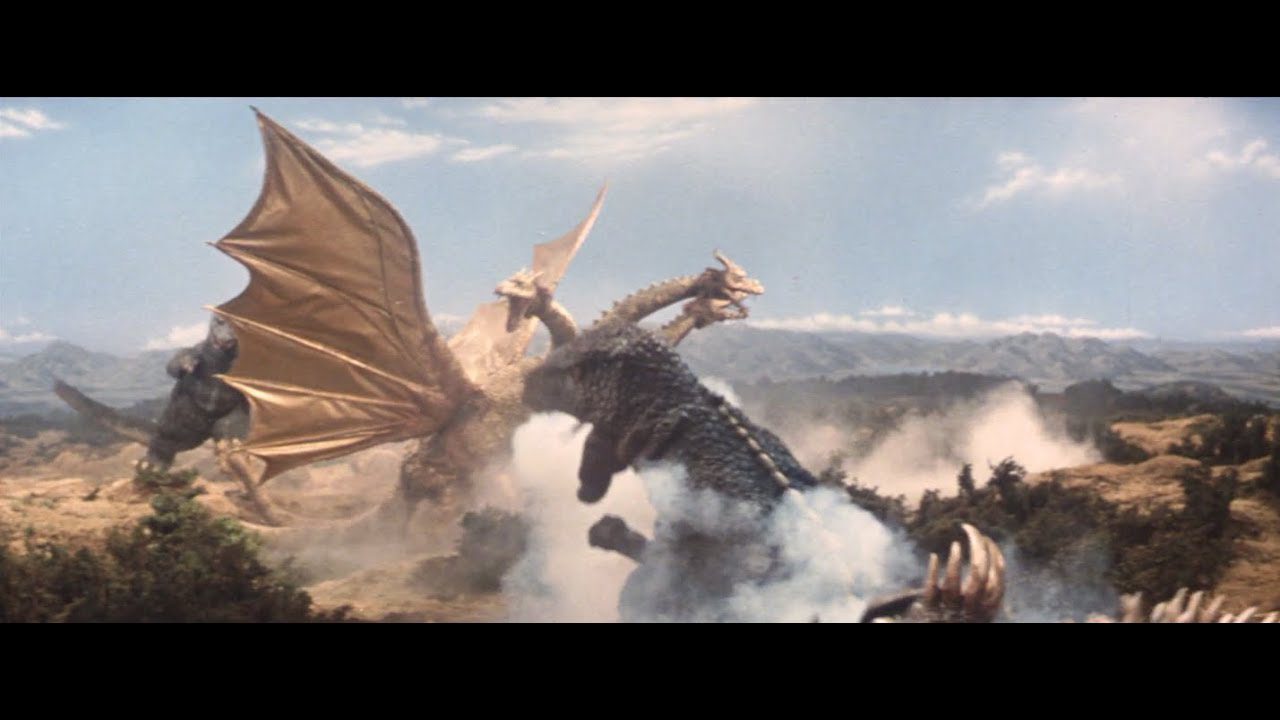
Monsterland in the Ogasawara Islands by the United Nations Science Committee.? Here, the monsters are prevented from going on destructive rampages and are studied.? The United Nations Science Committee also has a space program, with a base on the moon.
Suddenly communication with Monsterland is lost and the monsters begin appearing all over the world. Rodan attacks Moscow, Gorosaurus attacks Paris, Mothra attacks Beijing, and Godzilla attacks New York, targeting the United Nations Secretariat Building with his atomic breath.
It is soon discovered that the monsters and researchers who were at Monsterland are under the control of a race of aliens called Kilaaks. The Kilaaks are controlling the Monsterland researchers with devices behind their ears and there are devices hidden around the world that are being used to control the monsters.
Eventually Godzilla, Rodan, Manda, and Mothra appear in Tokyo, destroying the city. The Kilaaks are found to have a base under Mount Fuji. A military operation is launched to destroy the base, but the armed forces are driven back by the monsters guarding it.
Captain Katsuo Yamabe (Akira Kubo) takes his crew on the Moonlight SY-3 spaceship to the moon and manages to recover the master control device from a secret Kilaak base there. Earth takes control of the monsters and prepares for a final assault on the Kilaaks? Mount Fuji base.

Just before the attack can begin, the Kilaaks pull out their secret weapon to defend themselves: King Ghidorah! A massive brawl ensues and the Earth monsters finally kill the golden three-headed space dragon. With King Ghidorah defeated, Godzilla attacks the Kilaaks? base, ending the alien invasion.
The post-war economic prosperity that had allowed the proliferation of giant monster movies in the earlier part of the decade had also allowed for an increasing number of Japanese households to own televisions. By the late 1960s, it was easier and much more affordable to just stay home and watch programs like Ultraseven than to go see Godzilla or Gamera films in the movie theatres. In North America, Ebirah, Horror of the Deep and Son of Godzilla had been released directly to television, while Invasion of Astro-Monster still languished without a release at all despite being a Japanese-U.S. co-production starring Hollywood actor Nick Adams. It was becoming clear that major changes were on the way for the Japanese film industry, so the decision was made to end the Godzilla series.
With the intention of going out on a high note, Destroy All Monsters was given a bigger budget than the previous few Godzilla movies, and it really shows. There is a lot of special effects work in this movie, from giant monsters and miniature cities, to rocket ships and underground bases. A total of eleven monsters from previous Toho movies appear in this film, though some just briefly: Godzilla, Rodan, Mothra, King Ghidorah, Anguirus, Gorosaurus, Manda, Baragon, Varan, Kumonga, and Minya.

Destroy All Monsters was a major turning point in the series for a few reasons. It marks the last time all four of the key men who created Godzilla in 1954 made a Godzilla movie together, as special effects director Eiji Tsuburaya would pass away in January 1970. Also, this is the first film where Godzilla is depicted as a deliberate hero, and he would continue to be portrayed as a hero through Terror of Mechagodzilla (1975).
Unlike previous Godzilla movies which explored various Cold War concerns, Destroy All Monsters is a much more straight-forward monster movie. There really isn?t much in the way of thematic subtext. At most, there is a longing for a future in which humanity can overcome its divisions and collaborate as a species, internationally and without conflict, on furthering scientific and technological progress for the benefit of all. Unfortunately it is a dream that we still haven?t realized nearly a quarter of a century after the film?s setting.
Destroy All Monsters was released in Japanese cinemas on August 1, 1968 and AIP released the film theatrically in North America on May 23, 1969. For its North American release, the film was dubbed into English at Titra Studios in the United States and had a few very minor edits made to it. Destroy All Monsters was released on VHS and DVD in North America in 1998 by ADV Films in uncut widescreen with Toho?s own English dub, produced at Frontier Enterprises in Japan, as the only audio option. ADV released the same DVD with a CD of the film?s soundtrack as an extra in 2004 for Godzilla?s 50th anniversary. These releases are all out of print.
Destroy All Monsters was again released in North America in 2011, this time on DVD and Blu-ray by Tokyo Shock. This release was packed with extras and included the Japanese audio, Toho?s English dub, and the AIP dub. Unfortunately, some of the content on the disks had not been approved by Toho and this release was quickly put out of print, with just a handful of lucky fans that picked it up immediately upon release getting a copy of it. Tokyo Shock re-released the film on DVD and Blu-ray in 2014 without the extras or AIP dub, and this release is now also out of print. The original Japanese version of Destroy All Monsters, with Toho?s own English dub as an alternate audio option, is currently available as part of The Criterion Collection?s Godzilla: The Showa-Era Films, 1954-1975 Blu-ray set.



